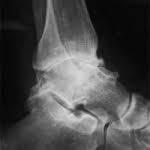Introduction
Ankle osteoarthritis, sometimes simply referred to as ankle arthritis, is a joint condition which results from damage and loss of the cartilage in a joint.
Cartilage is a highly specialised type of tissue which lines the end of bones and allows smooth movement of joints. Loss of, or damage to the cartilage can result in inflammation of the joint and sometimes leads to deformity.


Osteoarthritis Ankle Pain Symptoms
Ankle arthritis can cause stiffness, pain, swelling, deformity and problems with motion of the joint. Some patients will develop a bony protrusion known as an osteophyte or bone spur and this can lead to pinching of the lining of the joint and this is known as impingement.
In common with osteoarthritis elsewhere in the lower limbs (e.g. hip and knee), ankle arthritis can limit the amount of walking and standing an individual can do.
In the early stages, pain may only occur at the beginning and at the end of an activity but as the condition progresses the pain occurs more frequently to the extent that it can occur with each step and even at rest.
Causes of Osteoarthritis Ankle Pain
The commonest cause of ankle osteoarthritis is “post-traumatic” and can develop following a fracture of the ankle or even just repeated sprains. Unlike the hip and knee where osteoarthritis often occurs for no identifiable reason (primary OA), the ankle rarely develops arthritic changes without an identifiable cause.
The ankle is a complex joint which is subjected to huge forces during daily activities and especially during running. It is also the joint most commonly injured in the human body. This combination of factors predisposes the ankle joint to wear and tear changes.
Other causes of osteoarthritis are abnormal foot mechanics (flat and high-arched feet) and there are some diseases associated with arthritis such as haemochromatosis.
Diagnosis for Osteoarthritis Ankle Pain
The diagnosis of ankle osteoarthritis is made on the basis of the history and examination by an orthopaedic surgeon and is confirmed with weight-bearing X-rays. Sometimes other imaging such as MRI can be helpful in the early stages.
Osteoarthritis Ankle Pain Treatment
Non-surgical treatment
Non-surgical treatment of ankle arthritis should always be considered first as it might provide sufficient pain relief. This includes footwear modification, anti-inflammatory medication and physiotherapy in order to allow more flexibility and greater activity. Injections to lubricate the ankle joint or cortisone to damp down inflammation can help but at best their effect is only temporary. If conservative treatment fails to provide sufficient pain relief, surgery may be necessary.
Surgery for osteoarthritis
Arthroscopy (keyhole surgery) for ankle osteoarthritis allows the surgeon to assess and treat the joint from the inside using a minimally invasive approach. Arthroscopy allows the joint to be tidied up when the arthritic process is not advanced. However, it does not cure the condition or halt the progression of the condition.
The surgeon accesses the ankle through two or three small incisions and uses small instruments to remove loose fragments of bone, cartilage, scar and inflamed tissue. The surgeon can also smooth the cartilage surfaces of the joint.




